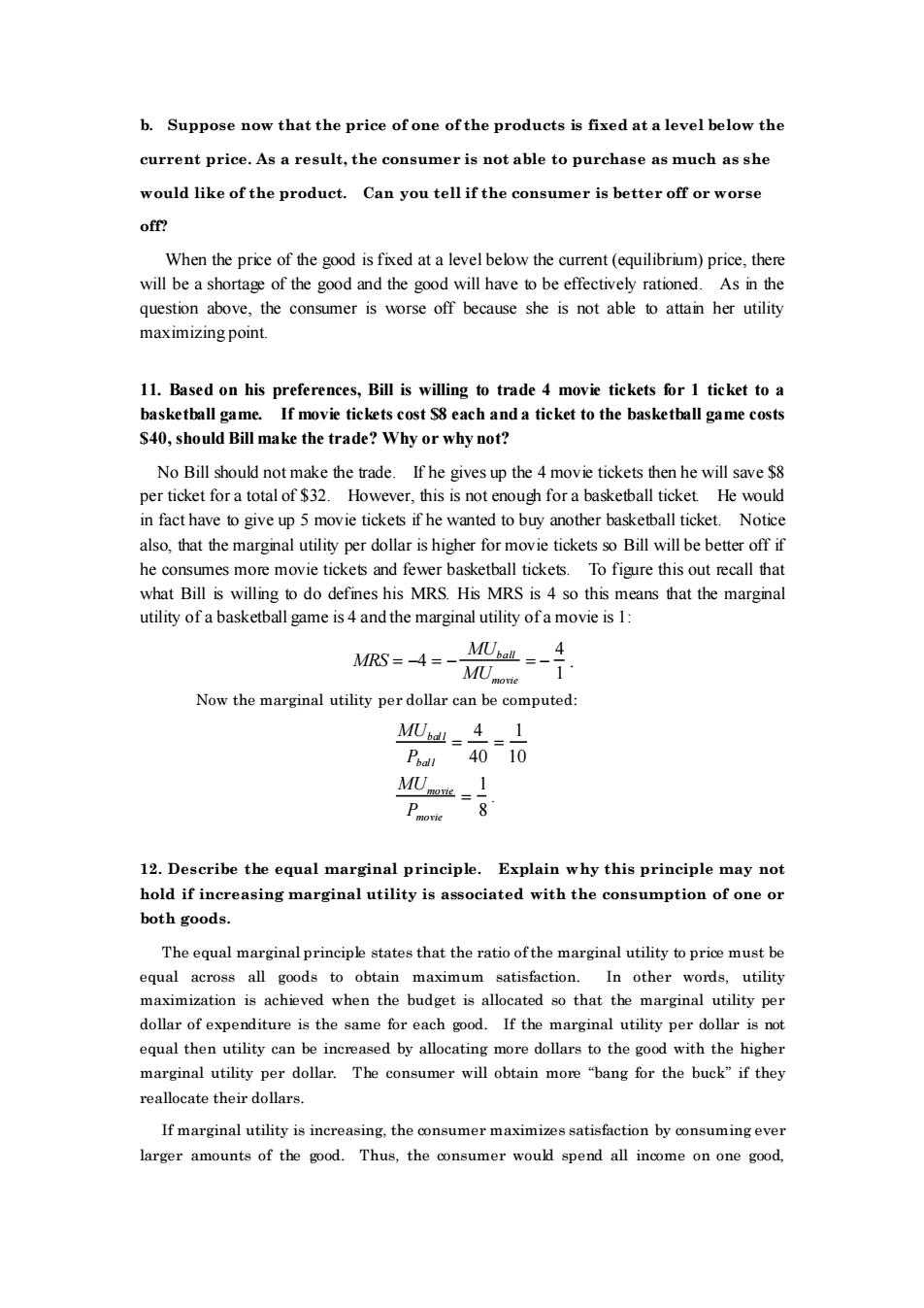正在加载图片...

b.Suppose now that the price ofone ofthe products is fixed at a level below the current price.As a result,the consumer is not able to purchase as much as she would like of the product.Can you tell if the consumer is better off or wors When the price of the good isfixed at a level belw the curent ()price.there will be a shortage of the good and the good will have to be effectively rationed As in th question above,the consumer is worse off because she is not able to attain her utility maximizing point. 11.Based on his preferences,Bill is willing to trade 4 movie tickets for 1 ticket to a baskethall game. If movie tickets cost 58 each and a ticket to the basketball game costs S40,should Bill make the trade?Why or why not? No Bill should not make the trade.If he gives up the 4 movie tickets then he will save $8 per ticket for a total of $32.However,this is not enoug for a basketball ticket He woul in fact have to give up 5 movie tickets if he wanted to buy another basketball ticket.Notice also,that the marginal utility per dollar is higher for movie tickets so Bill will be better off if he consumes more movie tickets and fewer basketball tickets.To figure this out recall that what Bill is willin utility of a ba all game is 4 and the marginal utility of a movie is 1 MRS=4-MU Now the marginal utility per dollar can be computed: 40=10 Po 12.Describe the equal marginal principle.Explain why this principle may not hold if in reasing marginal utility is associated with the consumption of one or both goods. The equal marginal principle states that the ratio of the marginal utility to price must be equal across all goods to obtain maximum satisfaction.In other words,utility maximization is achieved when the budget is allocated so that the marginal utility per dolar of expenditure is the same for each good.If the marginal utility per dollar is equal then utility can be g m e dollars to the goo vith the highe marginal utility per dollar.The consumer will obtain more "bang for the buck"if they reallocate their dollars. If marginal utility is increasing.the consumer maximizes satisfaction by consuming ever larger amounts of the good.Thus,the consumer would spend all income on one good.b. Suppose now that the price of one of the products is fixed at a level below the current price. As a result, the consumer is not able to purchase as much as she would like of the product. Can you tell if the consumer is better off or worse off? When the price of the good is fixed at a level below the current (equilibrium) price, there will be a shortage of the good and the good will have to be effectively rationed. As in the question above, the consumer is worse off because she is not able to attain her utility maximizing point. 11. Based on his preferences, Bill is willing to trade 4 movie tickets for 1 ticket to a basketball game. If movie tickets cost $8 each and a ticket to the basketball game costs $40, should Bill make the trade? Why or why not? No Bill should not make the trade. If he gives up the 4 movie tickets then he will save $8 per ticket for a total of $32. However, this is not enough for a basketball ticket. He would in fact have to give up 5 movie tickets if he wanted to buy another basketball ticket. Notice also, that the marginal utility per dollar is higher for movie tickets so Bill will be better off if he consumes more movie tickets and fewer basketball tickets. To figure this out recall that what Bill is willing to do defines his MRS. His MRS is 4 so this means that the marginal utility of a basketball game is 4 and the marginal utility of a movie is 1: MRS = −4 = − MUball MUmovie = − 4 1 . Now the marginal utility per dollar can be computed: MUbal l Pbal l = 4 40 = 1 10 MUmovie Pmovie = 1 8 . 12. Describe the equal marginal principle. Explain why this principle may not hold if increasing marginal utility is associated with the consumption of one or both goods. The equal marginal principle states that the ratio of the marginal utility to price must be equal across all goods to obtain maximum satisfaction. In other words, utility maximization is achieved when the budget is allocated so that the marginal utility per dollar of expenditure is the same for each good. If the marginal utility per dollar is not equal then utility can be increased by allocating more dollars to the good with the higher marginal utility per dollar. The consumer will obtain more “bang for the buck” if they reallocate their dollars. If marginal utility is increasing, the consumer maximizes satisfaction by consuming ever larger amounts of the good. Thus, the consumer would spend all income on one good